| [naar
inhoudsoverzicht muziekgeschiedenis]
[naar
inhoudsoverzicht korte biografieen]
[naar Schubert-
biografie
1]
[terug naar inhoud
Schubert-biografie 2]
[naar
literatuurlijst]
inhoud:
|
BIOGRAPHY

Franz Schubert around 1825
Franz Schubert was born on January 31st 1797 in Vienna and he died thirty-one
years old on November 19th 1828. He left approximately thousand compositions
- a lifework which appears even more colossal considering the shortness
of his life.
This life was not only short, but also lacking in "great" events in
comparison to other important composers. Schubert never played a particular
part in public life, he made just a few short journeys and lived basically
a inconspicuous life.
But the posterity could not accept the unspectacular biography
of the creator of such marvelous music and so the composer was exalted
to an unappreciated romantic genius with particular „gentle" traits some
decades after his death.
Since the middle of the 19th century, a long line of „biographic" novellas
and novels as well as innumerable sculptural portrayals, among them about
700 postcards, caused a false popularity of Schubert. The concrete facts
about the course of his life handed down scantily were „completed" by doubtful
„memories" and anecdotes.
The „biographic" Singspiel „Das Dreimäderlhaus", performed for
the first time in 1916 in Vienna, contributed to the diffusion of an utterly
distorted picture of Schubert: This work feigns authenticity by including
original compositions by Schubert. Off the handed down clichés,
our Schubert documentary is limited to a short summary of the secured facts
about his life, a short survey of his works and an outline of the Austrian
Schubert memorial places.
Origin and childhood
Franz Schubert was born on January 31st 1797 in Vienna as twelfth child
of the schoolmaster (teacher at a elementary school) Franz Theodor Schubert
(1763-1839) and his wife Maria Elisabeth Vietz (1756-1812). The father
moved in 1783 from Moravian Silesia (today Czech Republic) to Vienna and
the mother came from Bohemia. Only five of the fourteen children of the
couple lived to see their first birthday, among them Franz was the second
youngest. On February 1st 1797, he was baptized at the church „zu den vierzehn
Nothelfern", the parish church of the Viennese suburbs Lichtenthal, Thury,
Himmelpfortgrund, Althan and Michelbeurengrund (today Pfarrkirche Lichtenthal
or also called Schubert-Kirche).
At that time, the family lived in two rooms in the house „Zum roten
Krebsen", Obere Hauptstraße zur Nußdorfer Linie Nr. 72 auf
dem Himmelpfortgrund (today: Wien 9., Mußdorfer Straße 54).
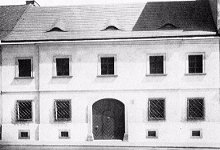
The birthplace at Nußdorfer Straße
Whoever visits the birthplace altered into a museum, should not be misled
by the solemn quiet atmosphere: At the beginning of the 19th century, there
were 16 smallest apartments here, offering an utmost inhospitable lodging
to the tenants.
The first floor housed a modest school, where the Schubert's father
teached for the time being just handful of children from poor families.
In spring 1801, he acquired by means of a mortgage the nearby house Säulengasse
3, called „Zum schwarzen Rössl", established a school there and moved
then also with his family to the own house. Franz Schubert went to the
elementary school of his father. The father gave him also the first music
lessons by teaching him violin playing. His brother Ignaz, his senior by
twelve years, instructed him in piano playing.

The court of the house „Zum roten Krebs"
The Schubert family made music regularly and the father was soon able
to form a string quartet, where the elder sons Ignaz and Ferdinand played
the violin, himself the violoncello and Franz the viola.
Outside the family, Michael Holzer, the Regens chori of the parish
church of Lichtenthal, strove for the musical development of Schubert.
He initiated him into the practice of a church musician, taught him for
instance the practical application of the thorough bass and the extempore
playing, the „preluding" on the organ.
Franz Schubert proved to be an extraordinarily talented student. Probably
already at the age of eight or nine, he tried his hand at the first compositions.
Only a „singing in C" for bass voice and piano without text (D1A) is maintained
from that time.
At the Stadtkonvikt (1808-1813)
With ten years, Schubert took part in High Masses at the parish church
of Lichtenthal as choirboy and violinist. His father presented him to the
highly esteemed Viennese court conductor Antonio Salieri (1750-1827), who
directed also the choirboys of the Viennese court music orchestra. He established
the outstanding qualification of Schubert and admitted him as choirboy.
Being a member of the choirboys meant a „foundation place" at the Stadtkonvikt,
the best boarding-school of Vienna, an excellent general education at the
Akademische Gymnasium (academic secondary school) and a first-class musical
support.
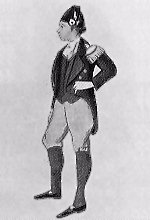
Uniform of the court choirboys
While Schubert's reports as court choirboy were brilliant without exception,
he made just slight progress in Latin, Greek and mathematics. He took part
as violinist in the orchestra of the school, which was founded by the art-loving
principal of the institute, father Innozenz Lang. They made music every
evening and played a complete symphony among other pieces. Haydn,Mozart
and Beethoven were the highlights of the repertoire, where also
composers feature which are already fallen into oblivion today, for instance
Anton Eberl (1785-1807), Leopold Kozeluch (1747-1818), Franz Krommer (1759-1831)
or Franz Anton Rösler alias Antonio Rosetti (1750-1792).
Joseph von Spaun about this time:
„Schubert played standing behind me from the same sheet of
music. I noticed very soon that the little musician surpassed myself in
reliability of the time. My attention having been drawn to him by it, I
noticed how the otherwise quiet and indifferent looking boy abandoned himself
lively to the impressions of the beautiful symphonies we performed."
The Viennese court organist Wenzel Ruzicka took the rehearsals.
He gave piano and thorough bass lessons to the pupils of the Konvikt. He
noticed also soon the extraordinary talent of Schubert and paid consequently
more attention to him.br> Schubert's mother died at the end of 1812. She
did not see her youngest son anymore since falling ill.
Schubert's entry in a music notebook of the court music orchestra
reads „Schubert Franz crowed the last time. July 26th 1812" - due to
the beginning breaking of the voice, he could not sing anymore with the
choirboys. His place at the Konvikt was preserved for another year, but
as his achievements in mathematics were consequently unsatisfactory during
this school year, he had to leave the boarding-school in autumn 1813.
At that time he had already composed a considerable number of
works in different genres: approximately fifteen lieder, eight string quartets,
one piano trio, five overtures, one symphony as well as numerous fantasias
and dances for piano and several unfinished compositions.
Approximately at the same time, as Schubert left the choirboys,
he became Antonio Salieri's student. The lessons with the famous opera
composer were concentrated on the field of the Italian arias and Schubert
composed for practice several arrangements of arias from the librettos
of Pietro Metastasio. Also numerous canons and fugues from that time are
supposed to have been composed for the lessons.
Teacher at an elementary school (1814-1816)
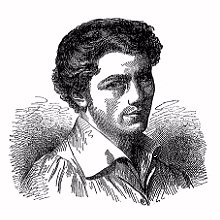
The seventeen-year-old Schubert
After leaving the Konvict in autumn 1813, Schubert returned to the parental
house in Himmelpfortgrung. In the meantime, his father had contracted a
second marriage with Anna Kleyenböck, the daughter of a silk dealer
from the suburb Gumpendorf. To be able to earn his living, Schubert began
a ten-month training to be a „school assistant", a sunordinate teacher
at an elementary school. He graduated from the „teacher's preparatory"
at the „k. k. Normalhauptschule St. Anna" with mediocre results. Then he
reported for the hated duty at the school of his father. This duty lasted
two years and these two years were at the same time compositionally the
most fruitful in his life. In his strict regulated day, a fixed stretch
was reserved exclusively for composition.

Schubert and Therese Grob
For the centennial of the parish church of Lichtenthal, Schubert composed
his first complete mass, the Mass in F major (D 105). At the first performance
on October 16th 1814, his friend of the youth Therese Grob sang the soprano
solo. Three days later, he composed the lied „Gretchen am Spinnrade", which
marked the beginning of the modern German lied.
Through Joseph von Spaun, his friend at the Konvikt, Schubert
got to know the young poet Johann Mayrhofer. He set several poems of him
to music. He owed his acquaintance of Franz von Schober also to Spaun.
Mayrhofer and Schober soon belonged to the closest circle of friends of
Schubert. He kept up a deep friendship also with Johann Senn and Anton
Holzapfel, two mates from the Konvikt.
As freelance composer
In April 1816, Schubert had a bitter professional disappointment. He had
applied for a post of music teacher in Ljubljana and his application was
rejected in spite of Salieri's recommendation. After this failure, he resigned
at school and moved with Joseph von Spaun to the Innere Stadt, to the house
of the professor Heinrich Joseph Watteroth (1756-1819) at Erdberger Straße
17. For the first time Schubert got money for a composition: Students of
the professor commissioned him to make a composition and he composed the
(missing) Cantata „Prometheus". It was performed on the name-day of the
professor on July 24th 1816, Schubert conducting.
In autumn, Schubert moved to the Schober family at Tuchlauben
in the Innere Stadt. He stayed as guest of the family till August 1817.
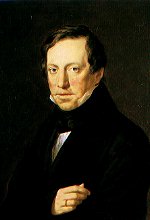
Franz von Schober
Till that time, he had composed already more than five-hundred works
- a wealth of lieder, several string quartets and five symphonies - but
his compositions were just known by a relatively small circle of friend
and music-lovers. In this regard, a change was impending with the move
to the Schober family: In their house, Schubert met the well-known court
opera singer Johann Michael Vogl (1768-1840), who pleaded for him as interpreter
in the following years and paved the way to the public for the lied composer.

The Schubert singer
Johann Michael Vogl
In February 1818, Schubert performed publicly also an orchestral work:
One of his two overtures in Italian style was performed in a concert at
the tavern „Zum Römischen Kaiser". These two overtures (D 590 and
591) were a response to the „Rossini fever" raging in Vienna since 1816
and the performance was not only a success with the public, but reaped
also appreciation of the critic of the „Wiener Allgemeine Theater-Zeitung".
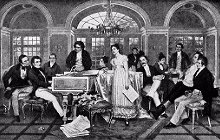
Schubert evening with Joseph von Spaun
In private circles of musicians, Schubert was already held in high esteem
and so he was proposed as music teacher to the Esterházy family.
From July to October 1818, he was invited as teacher at the country residence
of the Esterházy family in Zseliz in Hungary (today Slovakia), where
he gave lessons to the two daughters - later, he dedicated his piano fantasia
for four hands F minor (finished in 1828) to her.
Back to Vienna, Schubert and his friend Mayrhofer lived with a
tobacconist at Wipplingerstraße. He got in touch with a culturally-minded
circle around Ignaz von Sonnleithner (1770-1831). This circle of friends
performed important private concerts at Sonnleithner's apartment and was
found very useful to Schubert.
The years of crisis (1819-1822)
In summer 1819, Schubert came to Steyr in Upper Austria, the native
town of Vogl. One of the numerous lieder evenings, that he performed with
Vogl there, Schubert met Sylvester Paumgartner, an art patron and amateur
cellist, who commissioned Schubert to compose a piano quintet - later,
it became well-known as „trout quintet".
In this year, Schubert's circle of friends grew with the painter Moritz
von Schwind, which landscape pictures and portraits represent an important
pictorial documentation of Schubert's life.

Moritz von Schwind
In autumn, a period of personal and artistic unsureness began for Schubert.
He moved in circles of students kept under surveillance by the police.
Schubert's friend Johann Senn was arrested in his presence and Schubert
himself was cautioned for „maliciously reviling the authorities". Fragmentary
composition and relatively long creative processes are an evidence of the
creative crisis.
The just mediocre success of two plays contributed probably to the aggravation
of the situation: At the Kärntnertortheater the Singspiel „Die Zwillingsbrüder"
was performed for the first time in June 1820 and the melodrama „Die Zauberharfe",
composed in a few weeks, was performed at the Theater an der Wien. It is
true that the critics appreciated the „beautiful" music, but the plays
were soon taken off the program. The hoped-for breakthrough failed to come
and Schubert strove still in vain for a publishing house for his compositions.
Finally his friends took charge of the anticipatory finance for the printing
of the first songbooks published by Cappi & Diabelli.
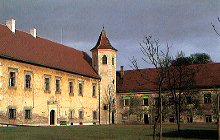
Atzenbrugg castle
In summer 1820, Schubert visited with his friends for the first time
Atzenbrugg castle in Lower Austria. It belonged to the possessions of the
Augustinian canons convent in Klosterneuburg and was managed by Josef Derffel,
an uncle of Franz Schober. He invited the circle of friends several times
to spend in summer some days at the castle and so the Schubertiads were
performed here in 1821 and 1822.

Excursion into the country
after a Schubertiad in Atzenbrugg
In Summer 1821, Schubert made several short journeys with Schober. In
late autumn, they lodged for a longer time in St. Pölten, were working
on a joint opera, „Alfonso und Estrella", and performed several Schubertiads.
From the end of 1821 to the beginning of 1823, Schubert lived mainly with
Schober at the Göttweiger Hof. In February 1822, he met the German
composer Carl Maria von Weber (1786-1826), who came to Vienna to conduct
a performance of his opera „Der Freischütz" at the Kärntnertortheater.
Weber is supposed to have promised him the performance of „Alfonso und
Estrella", but it was not to be.
The last years (1823-1828)
The last years of Schubert's life were outwardly determined by his syphilitic
disease and frequent moves. Despite all difficulties, he developed an astonishing
creative power, after overcoming the creative crisis of 1819/20.
At the end of February 1823, Schubert mentioned his disease for the
first time in a letter to a friend. During the summer, he was working on
his new opera „Fierabras" and made with Vogl a journey of several weeks
to Linz and Steyr. In autumn, he composed the drama music for Rosamunde.
Now he tried for the first time to get medical treatment and stayed in
hospital for a prolonged period. He composed there the lieder cycle „Die
schöne Müllerin".

The Stuttgart de luxe edition
of the „Müller lieder"
After his stay in hospital, Schubert lived with Josef Huber near the
Stubentor bastion.
In 1824, the Esterházy family invited him once again to come
to Zseliz and Schubert, supposed to be recovered, spent the summer months
there. Back to Vienna, he lived in the house of his father till February
1825. Then he moved to the surroundings of the Karlskirche in the neighborhood
of his friend Moritz von Schwind. He lived there till October 1826.

Schubert in 1825
In May 1825, he started off on his longest journey with Vogl. It lasted
just under six months and took the friends across Upper Austria and Salzburg.
During a longer stay in Badgastein, where Vogl hoped for cure of gout,
Schubert had probably also taken a cure. In Badgatein he composed several
lieder and was working on his great C major symphony, that he began in
Gmunden. At the beginning of October, he returned to Vienna via Linz.
In 1826, he had to suffer once more a professional defeat: His
application for the vacant post of Viennese vice-court conductor was rejected.
His efforts toward finding an editor for his works failed also for
the moment.
Nevertheless he was already rather well-known as composer in Vienna.
The newspapers published again and again advertisements of publishers and
his works were often performed in great public concerts. And when Ludwig
van Beethoven died in March 1827, Schubert had the honor of taking part
in the obsequies as one of the 36 torchbearers beside Grillparzer and Raimund.
In February 1827, Schubert moved with his friend Schober as subtenants
into two rooms and a „music chamber" in the house „Zum blauen Igel", Tuchlauben
14. He lived there till a few weeks before he died. He spent the September
1827 in Graz as guest of the lawyer Pachler and his wife Marie, a pianist.
Back to Vienna, he was working on the second part of his lieder cycle „Winterreise",
that he had begun already in February.
On January 28th 1828, a „great" Schubertiad with prominent guests
was performed with Joseph von Spaun at the „Klepperställe" in Vienna's
Teinfaltstraße: It was to be the last meeting like this. Encouraged
by the success, Schubert set about organizing - on his friend's Eduard
von Bauernfeld (1802-1892) advice - a so-called „private concert" with
exclusively own works. Exactly one year after Beethoven's death, on March
26th 1828, this concert was actually given at the hall of the Gesellschaft
der Musikfreunde (society of music-lovers) in the Tuchlauben. It was a
great artistic and financial success for Schubert - even though it was
totally outshone by the first Viennese concert of the famous violinist
Niccolo Paganini. Not a Viennese newspaper took notice of that unique event
in history of music.
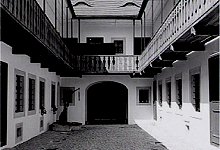
The house where Schubert died
(4th Viennese district)
In September 1828, Schubert went to live with his brother Ferdinand
in the Viennese suburb Neu-Wieden. He was in bad health - probably he had
contracted a typhoid infection. After an excursion to Eisenstadt in October,
his state went from bad to worse. Nevertheless he enrolled for studies
of the fugue with Simon Sechter (1788-1867), the famous theory teacher
and composer, and began also with composition exercises. But finally he
got just one single lesson.
From November 11th on, Schubert was confined to bed. He died on
November 19th. On November 21st, he was buried at the cemetery of Währing
near Beethoven's tomb and many people took part in the obsequies. When
the cemetery of Währing was closed in 1888, Schubert's mortal remains
were transferred to the Wiener Zentralfriedhof (Viennese central cemetery)
and interred in a tomb of honor.
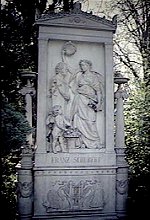
Schubert's tomb
The Schubertiads
In the course of the social changes after the Napoleonic wars at the beginning
of the 19th century, a new class upholding culture became established within
Austria's up-and-coming bourgeoisie thirsty for education, and a new market
for art appeared: the bourgeois salon. At the living rooms of the middle
class convivial evening entertainment events were performed giving the
only opportunity of critical political discussions and uncensored artistic
expression in the icy atmosphere of the police state.
An important part of theses events, besides eating, dancing, playing
and talking, were the literary and musical interludes performed by „professional"
artists or „dilettantes". The piano, the piano forte was an imperative
piece of furniture of the salon and became more and more in vogue in the
course of the 19th century.
Out of such private events the „Schubertiads" were formed, convivial
get-togethers of Schubert's friends and acquaintances, where the composer
played a central role. For him they were the occasion to present his new
compositions - especially his lieder - to a public kindly disposed toward
him. On the top of that, he contributed to the musical entertainment of
the soiree and improvised dance music.
The first verifiable Schubertiad was held at Franz von Schober's
place in Vienna on January 21st 1821.

Franz von Schober
Such meetings were not limited to the capital Vienna. We know about
Schubertiads in St. Pölten, Steyr, Linz and Graz. Among the Viennese
addresses of Schubertiads there are for instance the salon of Hofrat Josef
Witticzek, the houses of the Spaun and Schober families, the palace of
the banker Johann Heinrich Geymüller, the apartment of the actor Heinrich
Anschütz, the house of the university professor Heinrich Watteroth,
the summer-house of Princess Paar in Wien-Hütteldorf rented by the
Bruchmann family for the summer months 1819 to 1823. In Linz they met for
the Schubertiad at the house of the Spaun family, in Steyr at the salon
of Sylvester Paumgartner and in Graz at the salon of Marie Pachler.
Schubert's friends

Eduard von Bauernfeld (1802-1890)
-studied law in Vienna and entered the civil service in 1826. He was intimate
with Schreyvogel, Grillparzer and Schlegel. In 1848, he retired from the
public service in favor of poetry. His reputation as author was based on
his numerous comedies. In 1848, Bauernfeld became corresponding member
of the academy of sciences.
Anselm Hüttenbrenner (1794-1868)
-showed like Schubert already early his musical talent. He became also
a student of Salieri, who gave him free composition lessons during five
years. From 1824 on, Hüttenbrenner was director of the conservatory
in Graz. As composer he devoted himself to all musical genres.
Johann Baptist Jenger (1792-1856)
- was secretary of the Steiermärkischen Musikvereins (Styrian musical
society) and member of the board of the Gesellschaft der Musikfreunde (society
of music lovers) in Vienna.

Hüttenbrenner, Jenger,Schubert
Leopold Kupelwieser (1796-1862)
- studied at the academy of visual art in Vienna and was already soon a
sought after painter. He traveled a lot. In Rome, he joined the circle
of the „Nazarethians", a religious movement inside the Catholic church.
Kuppelwieser created altar-pieces in Moravia, Hungary, Transylvania and
Poland. He was employed with the Viennese academy since six years, when
he was appointed professor of history painting at this institution in 1836.
Johann Baptist Mayrhofer (1787-1836)
- prepared himself, according to his parents' request, four years for a
life as cleric at the Augustinian canon convent of St. Florian. But for
lack of conviction he abandoned this way and studied law in Vienna. In
1815, he entered the civil service as government conceptionist and book-auditor.
Due to his poetic ambitions, inner conflicts were inevitable while performing
such a duty. He committed suicide in 1836.
Franz von Schlechta (1796-1875)
- studied law and entered the civil service as revenue officer. He worked
his way up to be a division manager of the Imperial and Royal Ministry
of Finance and the title of privy councilor was bestowed on him at the
end of his career.
Franz von Schober (1798-1882)
- was born near Malmö in Sweden. After his secondary education, he
worked for a while as educator for noble families. In 1815, he began to
study law in Vienna. Schober made numerous journeys and met Franz Liszt
in Weimar in 1843. As chamberlain and legation councilor of the Grand Duke
of Sachsen-Anhalt he moved also in seigniorial society.
Moritz von Schwind (1804-1871)
- attened the Viennese Schottengymnasium with Bauernfeld and Lenau. From
1821 on, he studied at the academy of arts in Vienna. In 1828, he moved
to Munich and continued his studies with the painter Cornelius. During
a journey to Italy in 1835, he stayed for a while in Rome, where he was
on friendly terms with the artistic circle of the „Nazarethians". In 1847,
he was appointed professor at the academy of arts in Munich. Schwind was
working time and again on large orders, he was charged for instance with
the decoration of the loggia of the Viennese opera in 1863. In 1863, he
became honorary member of the Viennese academy.
Joseph von Spaun (1788-1865)
- studied law, entered the civil service and made an almost exemplary public
service career. In 1809, he began as trainee at the district office in
Linz. Two years later, he was already conceptionist trainee at the Ministry
of Finance. In 1818, he became court conceptionist, in 1841 Aulic Councilor
and director of the State lottery and in 1859 baron.
Albert Stadler (1794-1888)
- studied law in Vienna and entered the civil service in 1817 in Steyr.
In 1821, he moved to Linz. He was committee member and secretary of the
Linzer Musikverein (musical society of Linz).
Johann Michael Vogl (1768-1840)
- studied law in Vienna and was temporarily civil servant at the municipal
council, before he became as singer member of the Viennese court opera
in 1794. After his retirement in 1822, Vogl devoted himself to the interpretation
of lieder and the stage direction.
Heinrich Watteroth (1756-1819)
- studied law in Erfurt and Göttingen. From 1777 on, he was professor
of political science in Vienna. As liberal and anti-Catholic writer, Watteroth
had problems with the censorship.
|